After reaching the age of 15, teenagers in some parts of the United States can head over to the DMV and take a written test to possibly get a driver's permit -- the first official step in learning how to drive. It's essentially a license to practice, but it has its restrictions. To legally drive with a learner's permit, a teen must also have a licensed adult present in the passenger seat while the car's on the road. The idea, of course, is to provide the teen with on-the-road experience, while at the same time, the adult is there to instruct the novice driver on good driving skills.
The real sense of freedom, however, comes a little bit later -- sometimes a year later, other times a little longer -- when it's time to head back to the DMV to take both a written test and a road test. The mixed sense of nervousness, relief and freedom one feels after passing the tests and receiving a driver's license can be a feeling most high schoolers will remember in the coming years. Having the independence to drive on your own or with friends is something many look forward to once they have their new license in hand.
Advertisement
But as fun, liberating and grown-up as it might feel for a new driver to finally hit the road, there is increasing concern over the safety issues that come with teen driving. In fact, motor vehicle crashes are the leading cause of death among teenagers in the U.S., accounting for more than a third of all deaths for people between the ages of 16 and 19 [source: Centers for Disease Control and Prevention].
To combat this, parents, state governments and other organizations are devising ways to educate new drivers, including tougher laws and restrictions and a more involved graduated driver licensing (GDL) systems that give teens as much experience as possible before they receive full licensure.
A popular current trend, however, involves using GPS computer technology to track and monitor teen driving habits. One of these devices is the Tiwi, developed by Inthinc, and its makers claim it's a "breakthrough" in monitoring technology. There are several of these types of devices already on the market, so how is the Tiwi different?
Advertisement




